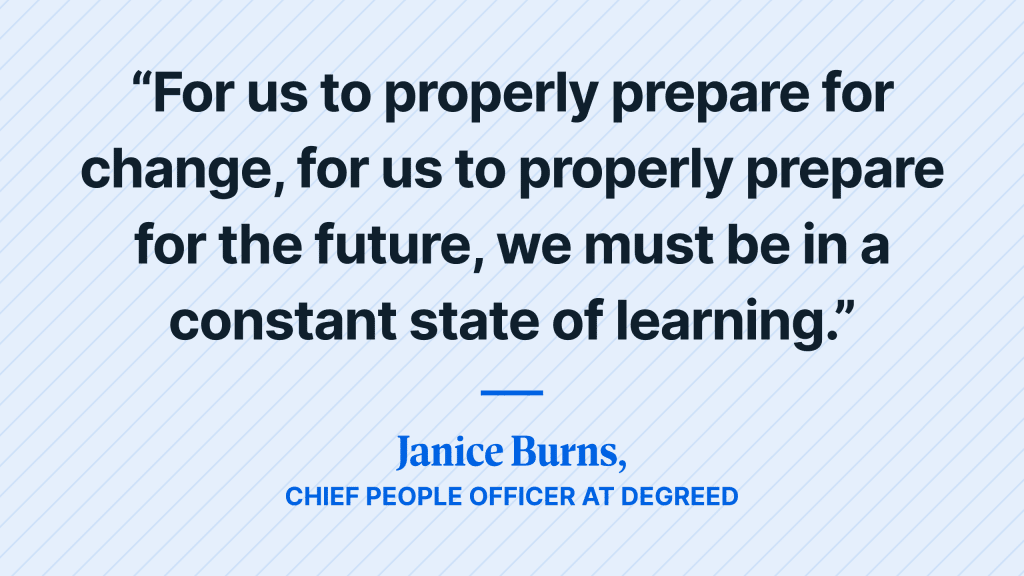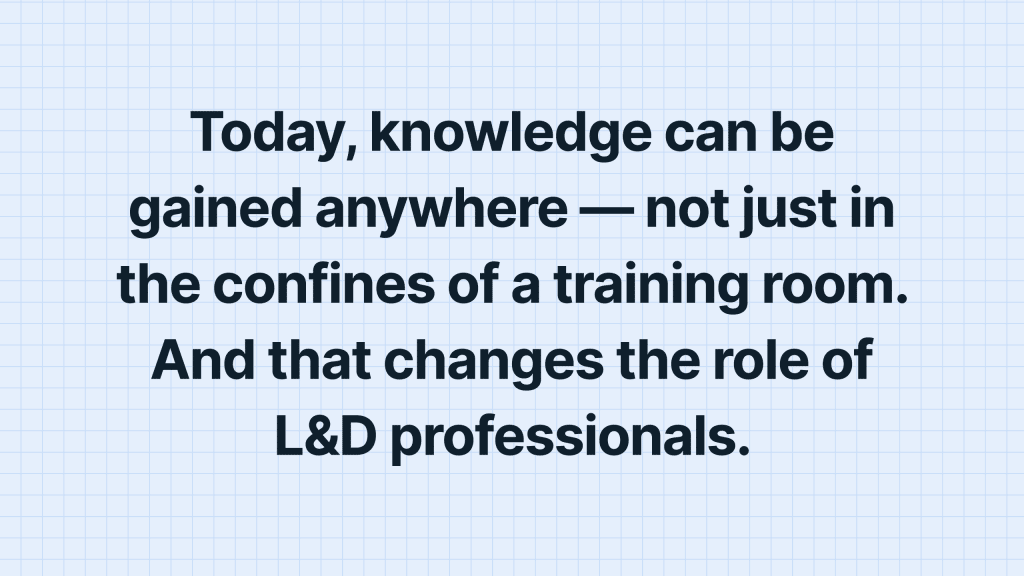Businesses tend to adapt to modern advancements — embracing computers, cell phones, remote conferencing and more. Yet those adjustments are often reactive. Companies don’t always prepare for the next big change.
Just look at what L&D pros are doing right now: They’re navigating away from in-person classes and steering toward virtual learning. They’re going from competency models to skill strategies and tossing out on-paper completion forms in favor of advanced, dynamic learning experience platforms (LXPs) — all in response to advancements in the world of work. And it’s keeping them busy.
But what would happen if learning pros stopped to ask “what’s next?” They’d get to decide how to make learning better, to reimagine the future of learning, instead of waiting for the next big shift.
Imagining what learning will look like six months, a year, or even five years from now is exactly why industry experts gathered for recent Degreed Insight events for North America and Europe. Speakers and attendees explored how they — and the industry — can make new, limitless strides.
“If our technology is inherently upgradeable, so are we,” said Vidya Krishnan, Chief Learning Officer at Ericsson.
Changing learning tactics and methods before knowing what’s next is a challenge. The good news is that answering “how?” is something L&D pros excel at.
“We know that change is constant and change will happen,” Janice Burns, Chief People Officer at Degreed, said. “For us to properly prepare for change, for us to properly prepare for the future, we must be in a constant state of learning.”

Speaker after speaker agreed: At its core, learning has to be about people.
“It’s people that learn. And if we don’t help people learn, then nothing is going to work,” said Donald Taylor, Research and Chair at the Learning Technologies Conference.
Your People Are the Future
Times change because people change. They explore new values and ideas — new normals. As a learning professional, it’s important to keep that in your sights as you continue to enhance L&D at your organization.
“If we’re not pulsing and keeping track of how people’s values are shifting, what they need, what they want, what they’re experiencing, we’re going to miss the moment,” said Seth Mattison, Co-Founder and CEO of FutureSight Labs.
One example of a value shift is a growing need for convenience in standard day-to-day work tasks and activities. It’s become even more of a necessity as a result of the COVID-19 pandemic, and L&D professionals are re-evaluating strategies to meet people where they’re at. But there’s always more to do.
“Learning should be made easy,” Krishnan said. “That’s all about enabling our ecosystem to truly be an engine for skills at scale, so that the learning finds the people and not just the other way around.”
Giving your people space to learn also gives them space to help your company succeed.
“We really believe that the growth of our people, in that sense, fuels the growth of our company,” Krishnan said.
L&D Pros Shape the Future
If people are going to learn their way to the future, the importance of your contributions as a learning and development professional is clear: you’re impacting and shaping what work will look like tomorrow, Mattinson said. “You are in this incredibly unique position that you get to put your fingerprints on it.”
Tools and technologies are one way to help you achieve goals, but it’s important to remember they’re managed by people like you.
“You are the magic,” Mattison said. “There are all these new tools that are rolling out. . . But never forget that your greatest magic is the way in which you show up and the presence that you bring to the people around you, the courage and curiosity for them to lean into the future.”
Preparing and Improving the Future with Learning
You can shape the future with enhanced learning experiences. Here’s how:
Focus on people.
First and foremost, learning is done by people. Their experiences, values, interests and skills guide the journey.
Taylor emphasized there is no one final destination of enlightenment in a learning journey. This gives L&D professionals an opportunity to focus on improving the experience. “It never ends, so how do we make that journey as effective, as pleasurable and as good for the participant as possible?”
A people-centric mindset can help you make the right decisions about your learning strategy. As long as it’s focused on creating the best experiences for your people, you’re likely on a good path and can use creativity to propel you from there.
In that vein, learning leaders at Standard Bank Group stopped fulfilling any and all requests and shifted to a more thoughtful approach to providing valuable learning experiences.
“Instead of saying ‘there’s an app for that,’ we say ‘ there’s a course for that.’ And the moment the business jumps up and down, we reach out and create a course or a learning pathway,” said Lucy Voss-Price, Group Head of Learning at Standard Bank Group. “And [our team] decided to focus much more on where that learning might take place, the conditions under which it might take place.”
Liberate knowledge.
Today, knowledge can be gained anywhere — not just in the confines of a training room. And that changes the role of L&D professionals.
“Information has gone from being a source of power to being commonplace,” Taylor said, noting that L&D professionals still often act as gatekeepers of information. Instead, they should acknowledge and appreciate the many forms learning can take.

And as Kelly Palmer, Chief Learning and Talent Officer at Degreed, said: ensure learning is tracked. “A lot of people are already learning in the flow of work, but they’re not necessarily getting credit for it… The reality is that we’re learning all the time, every day.”
Integrate learning into work.
Helping people find time to learn throughout the work day is still one of the learning industry’s greatest barriers to engagement.
The key is to make learning at work inevitable by weaving skill-building projects into day-to-day activities and real business goals. If work and learning become the same thing, it’s much easier to make time to do it, Palmer said.
Another important element connecting learning and work is collaboration. Use that connection to ensure teams already working together each day include people with a variety of skill sets and experience levels to use mentorship as another way to learn.
“A great learning culture demands a great teaching culture where people making contributions to amplify the skills of others recognizes that this is how we learn,” Krishnan said. “Building skills is what happens to us on the way to solving problems that matter, together.”
When problems are solved collectively, it benefits the business as well as the individual. It also sets up a culture of adapting to challenges and addressing them head-on.
Anticipate and embrace change.
With the right learning strategy, workforce development technology, and L&D team, you don’t need to fear the unknown.
And as the need for skills constantly expands and shifts, causing friction at fast-growing companies that struggle to keep up, focusing on skills sooner rather than later can help avoid more problems.
“If we do not focus on skills and they continue to change faster and faster,” said Peter Sheppard, Head of Global L&D Ecosystem at Ericsson. “The pain points we’re feeling right now aren’t going to get any better. They’re just going to get worse.”
Change can be scary. But if you’re prepared, and if you make it about people, it can also be exciting and promising.
“Just have a bit of courage,” Taylor said. “Step out and do it and let’s get the learning support to the people when they need it.”
